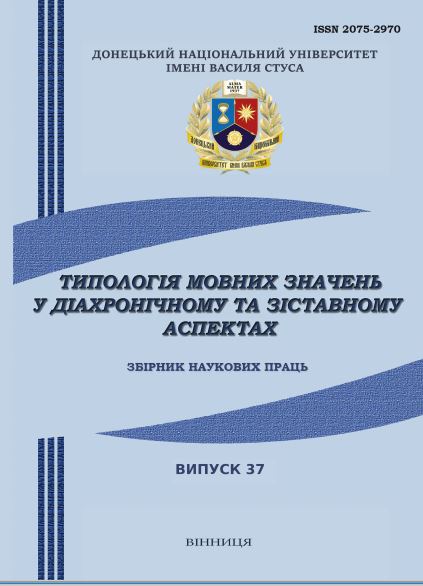Structure of Old English Simile of Equality with the Gelice/Onlice/Anlice Component.
DOI:
https://doi.org/10.31558/2075-2970.2019.37.7Keywords:
Old English, simile, tenor, vehicleAbstract
This article intends to characterise Old English simile of equality with the comparison marker gelice / onlice / anlice. It is a part of a large-scale systemic investigation of Anglo-Saxon similes, being done for the first time. This study is the attempt to systematise Anglo-Saxon poetic comparisons with the attributive / adverbial marker of comparison in positive degree, which are the predecessors of modern English simile with like. The empirical material of the investigation is the corpus of Old English manuscripts of University of Toronto. The criteria of the structural classification of the figurative comparisons under consideration are described in the paper. The scope of the analysed units is organised into two major groups, depending on the case of a noun that expresses the vehicle: Dative or Nominative. Eight structural models are distinguished, depending on the positioning and grammatical expression of the structure components (tenor, vehicle, ground and the comparison marker of the simile), with the further analysis of their statistics and chronological features. It has been estimated that the most productive structure of the similes in question is the combination of two nouns (the second one being the vehicle in Dative case) with the postpositional marker of comparison. The article deals with all existing Old English similes with the component gelice / onlice / anlice, harvested from surviving Anglo-Saxon manuscripts belonging to various text genres: riddles, poetry, Christian canonical texts. The research results contribute to the discussion of the date of composition of Christ and Satan, being an additional argument in favour of the version of a later period – the ninth century, during the reign of king Alfred.References
Amodio, Mark C. (2014). The Anglo-Saxon Literature Handbook. Wiley Blackwell.
Anderson, Orval. (1951). Once More: the OE Simile. Philological Papers 8. 1–12.
Baker, Peter S. (2012). Introduction to Old English. Wiley Blackwell.
Beardsley, Monroe C. (1981). Aesthetics: problems in the philosophy of criticism. Hackett Publishing.
Bradley, Sidney Arthur James (1995). editor. Anglo-Saxon Poetry. Everyman.
Cavill, Paul. (1999). Maxims in Old English poetry. Cambridge : D. S. Brewer.
Clubb, Merrel Dare. (1925). editor. Christ and Satan an Old English Poem. Yale University Press.
Dawes, Gregory W. (1998). The body in question: metaphor and meaning in the interpretation of Ephesians 5: 21–33. Leiden : Brill.
Finnegan, Robert Emmett. (1997). Christ and Satan A Critical Edition. Wilfrid University Press.
Fisher, Olga. (1992). Syntax. In Norman Blake (ed.), The Cambridge History of the English Language. Vol. II: 1066–1476. 207–407. Cambridge University Press.
Gergel, Aleksandr. (2014). Obraznye paradigmy sravnenij, xarakterizuyushhix muzhchinu i zhenshhinu (na materiale sovremennoj angloyazychnoj zhenskoj prozy). Avtoref. dis. na soiskanie nauch. stepeni kand. filolog. nauk : spec. 10.02.04 "Germanskie yazyki". Ufa.
Gergel, Remus. (2008). Comparatives and Inversion in English: A (Necessarily) Diachronic Account. U. Penn Working Papers in Linguistics. Volume 14.1. 177–190.
Margolis, Joseph. (1957). Notes on the Logic of Simile, Metaphor and Analogy. American Speech: Vol. 32, No. 3. 186–189. Duke University Press.
McLaughlin, John. (1983). Old English Syntax. Max Niemeyer Verlag: Tübingen.
Merritt, Carlton C. (2013). Descriptive Syntax of the Old English Charters. Berlin : De Gruyter.
Mitchel, Bruce. (1985). Old English Syntax. Oxford: Clarendon Press.
Nevanlinna, Saara. (1993). The Structure of Middle English similes of equality. Early English in the Computer Age: Explorations Through the Helsinki Corpus. 139–170. Berlin ; New Yourk : Mouton de Gruyter.
Oleniak, Mariana. (2018). Davnioangliyski obrazni porivniannia z komponentom gelicra. Modern Scientific Challenges And Trends. Warsaw: iScience. 82–84.
Oleniak, Mariana. (2018). Old English Simile of Equality: The Highest Degree of Similarity. Research in Language. Germany: De Gruyter, vol. 16 (4). 471–493.
Sleeth, Charles. (1982). Studies in Christ and Satan. Univeristy of Toronto Press.
Stodnick, Jacqueline, Trilling, Renee R. (2012). A Handbook of Anglo-Saxon Studies. Wiley Blackwell.
Walker, Marilyn A. (2016). Automatically Inferring Implicit Properties in Similes. Proceedings of NAACL-HLT. 1223–1232. San Diego, California.

